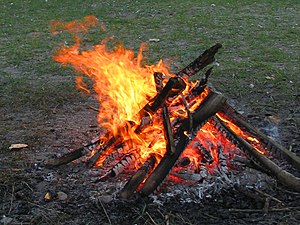 Image via Wikipedia
Image via Wikipedia61 wildfires reported so far this fall
MADISON – With 61 wildfires already reported this fall in areas of Wisconsin where the state Department of Natural Resources is responsible for fire protection, state officials are cautioning the public that wildfire activity could be a significant problem this fall and they are asking hunters, recreational vehicle operators and other outdoor recreationists to use extra caution in the outdoors this year.
Traditionally, the primary fire season in Wisconsin is in spring after the snow disappears. However, when summer ends and the leaves fall, the risk of wildfire increases again. A dry summer and unseasonably warm fall temperatures are increasing the risk this fall.
Only two weeks into October, the 61 wildfires reported have burned one building and threatened at least 24 others, according to Jolene Ackerman, a wildfire prevention specialist with the DNR Division of Forestry.
The dry conditions are an even greater concern across Polk, Burnett, Washburn, Douglas and Bayfield counties due to the July 1, windstorm that damaged more than 106,000 acres of forest and left many landowners with major damage to woodlands. The salvage of blown down timber is underway to reduce fuel loads for wildfire potential. People in the blow down area can check a storm recovery page on the DNR website or call the toll free DNR information line at 1-888-WDNRINFo (1-888-936-7463) for information on how to deal with wind damaged timber.
“This recent fire activity has been attributed to people burning debris, working with equipment, having campfires or warming fires, and dumping ash outdoors,” Ackerman said.
During fall and early winter months, hunting is a common activity. Unfortunately, this leads to wildfires from abandoned cooking or campfires or improperly disposed of smoking materials, and hot exhaust systems from trucks and ATVs.
Additionally some hunters have been known to use fire in the base of a hollow tree in an attempt to smoke out game animals. Using fire in this manner is a hunting violation. It is also an illegal breach of burning regulations. It can cause fires in remote locations after the hunter has left the area.
Forestry officials encourage people planning to spend time outdoors to check on the latest fire conditions and restrictions. Anyone deciding to have a campfire or warming fire should maintain at least a 3-foot clearing around the fire and keep the fire small. Always keep water and a shovel handy and keep the fire attended. When finished, drown and stir the fire with water and a shovel until the fire is out. Before leaving the area, check the ashes with the back of the hand for any warmth and repeat the wetting process until the fire is 100 percent dead out.
Improper ash disposal is another cause of wildfires this time of year. When disposing of ashes from a stove or fireplace, fire prevention specialists recommend placing ash and coals into a steel bucket or metal garbage can until completely cold. The ash can then be disposed of by spreading on bare ground such as a tilled garden or plowed field. Otherwise ashes can be spread out, wetted down and stirred to extinguish any embers that may still be smoldering.
ATV and other vehicle users in the forests should check around their mufflers for dry grass, leaves and pine needles. This debris can turn to a smoldering cinder, fall off on a grassy backwoods trail, and start a fire.
All people working or playing outdoors are asked to be aware of the wildfire potential in the fall with the abundant dead and dry vegetation all around and to use caution with anything that could start a wildfire. For more information on how to prevent wildfires, and for obtaining current information on any fire restrictions in effect, contact your local DNR Service Center, Ranger Station, or visit thhe forest fire program pages of the DNR website.
FOR MORE INFORMATION CONTACT: Jolene Ackerman – (608) 267-7677


No comments:
Post a Comment